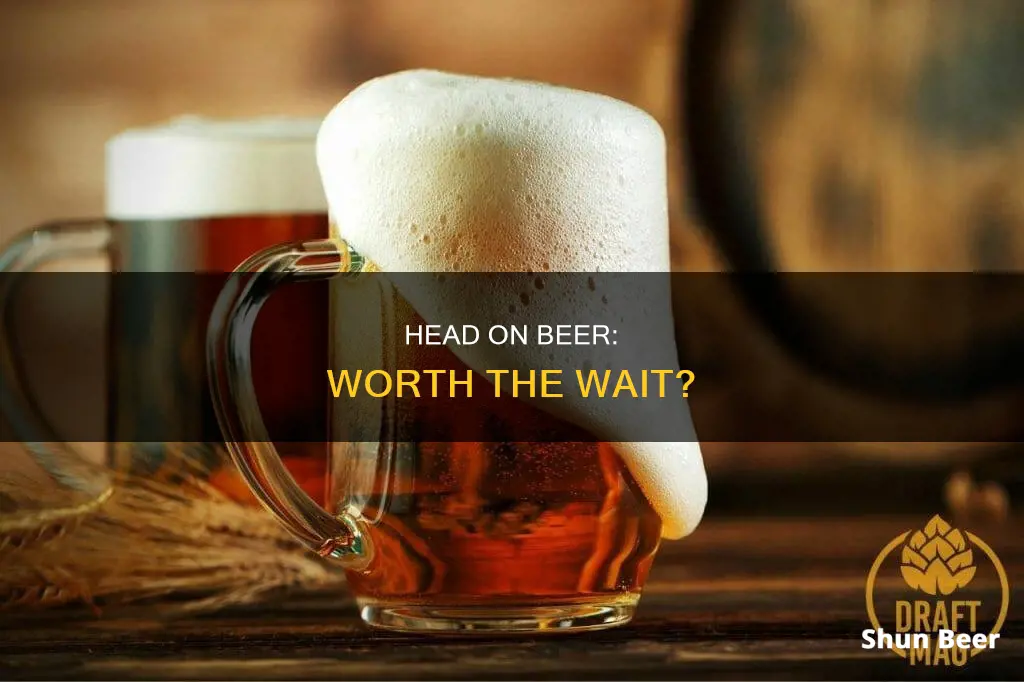
The foamy substance at the top of a beer is called the head. It is formed by the nucleation process, which involves carbon dioxide interacting with foam-positive proteins like Lipid Transfer Protein (LTP1). The head of a beer is not only visually appealing but also serves a practical purpose. It enhances the drinking experience by reducing the overall carbonation of the beer, thereby lessening the amount of carbon dioxide that enters your stomach and causing bloating. The head also affects the taste and aroma of the beer by drawing out the carbon dioxide and fizziness, allowing you to experience the full range of flavours. While the presence of a head is generally desirable, the optimal amount of foam can vary depending on personal preference and the style of beer.
| Characteristics | Values |
|---|---|
| Purpose of a head on a beer | Quality control, better taste, better aroma, better drinking experience, prevents early oxidation |
| Formation of a head | Nucleation, caused by carbon dioxide interacting with foam-positive proteins |
| How to get a good head | Pour beer down the side of a glass at a 45-degree angle |
| Ideal amount of head | 0.5-1 inch |
What You'll Learn
- The head of a beer is formed by the nucleation process, where bubbles form due to carbon dioxide interacting with hydrophobic proteins
- The head of a beer is desirable as it enhances the drinking experience, making the first sip almost ethereal
- A beer head can be created by tilting the glass at a 45-degree angle and pouring the beer against the edge of the glass
- A beer head is important for quality control, indicating the freshness of the beer when stored in wooden casks
- The foam in a beer head is derived from malted barley, hops, and yeast, and it contains compounds responsible for the beer's aroma and flavour

The head of a beer is formed by the nucleation process, where bubbles form due to carbon dioxide interacting with hydrophobic proteins
The head of a beer is an important part of the drinking experience. It is the foamy substance at the top of the beer, formed by the nucleation process. Nucleation is the process by which bubbles form and rise to the top of the beer. This occurs due to the interaction of carbon dioxide with hydrophobic proteins.
During beer production, carbon dioxide (CO2) is naturally produced as a byproduct of yeast metabolism acting on starches and sugars in the wort. Additional CO2 may be added during packaging to maintain freshness. When the beer is poured, the carbon dioxide in the beer escapes and rises to the surface, forming bubbles. These bubbles are stabilised by hydrophobic proteins, such as the Lipid Transfer Protein (LTP1), which repel water and connect with the carbon dioxide. The combination of LTP1 and carbon dioxide creates the foamy head on the beer.
The presence of hops in craft beers also contributes to a stronger and more stable head. Hops contain hydrophobic proteins that make the foam more rigid and thick. The density and longevity of the head are influenced by the type of malt and adjunct used in fermentation, with wheat generally producing larger and longer-lasting heads than barley.
The head on a beer serves several purposes. Firstly, it enhances the aroma of the beer, which is an essential component of the overall flavour profile. Secondly, it reduces the overall carbonation of the beer, resulting in less carbon dioxide entering the drinker's stomach, which can help prevent bloating. Additionally, the head affects the drinking experience aesthetically and texturally, encouraging a slower drinking pace and protecting the beer from early oxidation.
To achieve the perfect beer head, skilled bartenders follow specific techniques. When pouring, the glass is tilted at approximately a 45-degree angle, ensuring that the beer hits the side of the glass. After a few seconds, the glass is slowly returned to its upright position, and the pouring is continued. This method results in a tasty and perfectly foamy head.
Beer and Cutting: Is It Possible to Enjoy Both?
You may want to see also

The head of a beer is desirable as it enhances the drinking experience, making the first sip almost ethereal
The foam or head helps to contain the volatile compounds responsible for the beer's aroma, keeping them around longer for your enjoyment. As the foam dissipates, it releases these compounds towards your nose, allowing you to perceive the full range of aromatic compounds in the beer. This enhances the drinking experience, making the first sip almost ethereal as it caresses the palate before disappearing.
The head of a beer also has a practical function. It helps to protect the beer from early oxidation, preserving its freshness and quality. Additionally, it helps to release flavours by drawing out the carbon dioxide and fizziness, making the flavour profile more diverse and enhancing the overall drinking experience.
Creating a good beer head is a sign of a quality bartender or server. It demonstrates their skill and attention to detail in presenting the beer in the best possible way. The ideal amount of head on a beer is typically considered to be about half an inch to one inch, although this may vary depending on personal preference and the style of beer.
In conclusion, the head of a beer is not just a visual garnish but an integral part of the drinking experience. It enhances the aroma, flavour, and texture of the beer, making that first sip a truly ethereal pleasure. So, the next time you're served a beer with a generous head, savour it and appreciate the art and science that went into creating that perfect foam.
Beer and Alcohol: Safe Without a Gallbladder?
You may want to see also

A beer head can be created by tilting the glass at a 45-degree angle and pouring the beer against the edge of the glass
When it comes to pouring the perfect beer, creating a beer head is an important step. The beer head is the foam that forms at the top of the beer as it is poured, and it enhances both the taste and the drinking experience. A beer with no foam can often taste flat, and the presence of foam indicates proper carbonation.
To create a beer head, tilt your glass to a 45-degree angle and pour the beer against the edge of the glass. This technique allows the beer to slide down the side of the glass smoothly, reducing the chance of spillage and creating the perfect amount of foam. The angled pour also helps to separate the CO2 molecules from the beer, allowing them to dissolve outside the glass. This ensures that any excess carbonation does not negatively impact the drinking experience.
Once the glass is about half full, gradually bring it back to the upright position and continue pouring. This step helps to create a proper head of foam. For bottled or canned beer, aim for the midpoint of the glass when pouring to avoid splashing and releasing too much carbonation.
The thickness of the beer head depends on the type of beer. Craft beers, for example, are known for producing great foam heads due to the presence of hops, which contain proteins that make the foam more rigid and thick. A good beer head should be around one-half inch to 1.5 inches thick.
Creating a beer head is not just about aesthetics; it also improves the drinking experience by enhancing the flavour and reducing the overall carbonation of the beer. So, the next time you pour yourself a cold one, take the time to tilt your glass and create the perfect beer head.
Jackfruit and Beer: A Risky Culinary Adventure?
You may want to see also

A beer head is important for quality control, indicating the freshness of the beer when stored in wooden casks
The foamy substance at the top of a beer is called the "head" or the "collar". The process of bubbles forming in a drink is called nucleation, which is caused by carbon dioxide interacting with foam-positive proteins like Lipid Transfer Protein (LTP1). The head of a beer is important for quality control and can indicate the freshness of the beer when stored in wooden casks.
Back when beer was traditionally stored in wooden casks, the pouring process was developed as a sort of "quality control" measure. To tell if the beer was fresh, it was simply poured from the cask, and if it had a head, it implied that the beer still had carbon dioxide content and was therefore fresh. No beer foam and no head meant that the brew was likely stale or of lower quality.
The head of a beer also enhances the drinking experience. It changes the texture of the first sip and caresses the palate before disappearing. It also helps to drink slowly, as it protects the beer from air and early oxidation. Additionally, it can draw out the carbon dioxide and fizziness, making flavour profiles more than just "yeasty". For craft beers, it can be hard to taste the rest of the flavour profile if there is not enough foam.
The head of a beer also enhances the aroma and flavour of the beer. A large part of taste is the aroma, and the head gives off a more full and detectable aroma, essentially locking in a more potent flavour. The foam will bring the beverage odour compounds to the surface of the beer, opening up your nose so you are able to experience the full flavours.
The amount of head on a beer can vary depending on personal preference and the type of beer. While some beers, such as English real ales, have very little or no head due to lower levels of carbonation, other beers, such as craft beers, are known for their great foam heads. Ultimately, the head of a beer is an important part of the drinking experience, enhancing the flavour, aroma, and texture of the beer.
Beer and Pregnancy Tests: What You Need to Know
You may want to see also

The foam in a beer head is derived from malted barley, hops, and yeast, and it contains compounds responsible for the beer's aroma and flavour
The foam in a beer head is derived from malted barley, hops, and yeast. It contains compounds responsible for the beer's aroma and flavour. The foam is formed by the carbon dioxide produced as a byproduct of the metabolism of brewer's yeast acting upon starches and sugars found in the wort. The foam in a beer head is created by the carbon dioxide produced as a byproduct of the metabolism of brewer's yeast acting upon starches and sugars found in the wort. The wort protein, yeast, and hop residue are the elements that produce the head.
The foam in a beer head contains compounds that are responsible for the beer's aroma and flavour. The foam consists of polypeptides of five different classifications, divided by their relative hydrophobicity. As the hydrophobicity of the polypeptide groups increases, so does the stability of the foam.
The foam in a beer head is also influenced by the type of glass it is served in. Beer glassware is often designed to accentuate or accommodate the head. For example, a roughened surface at the base of the glass known as a widget provides nucleation of carbon dioxide deep in the beverage rather than at the surface, resulting in a slower release of gas to the atmosphere.
Kelly Slater's Beer Habits: A Surfing Legend's Beverage Choice
You may want to see also
Frequently asked questions
No, you don't have to wait for the head on beer to drink it. The head on a beer is the foam at the top, which is created by the nucleation process of bubbles forming in the drink. It is not just aesthetically pleasing but also serves a practical purpose. The head on a beer enhances its flavour and aroma, and also makes the drink less carbonated, reducing the amount of carbon dioxide that reaches your stomach.
The foamy head on a beer is caused by a process called nucleation, where bubbles form in your drink due to carbon dioxide interacting with foam-positive proteins like Lipid Transfer Protein (LTP1). LTP1 is hydrophobic, so it avoids water. When beer is poured, LTP1 connects with carbon dioxide in the air, in the beer, and moves away from the water in the drink. The result is the formation of the head, which consists of LTP1 and carbon dioxide bubbles.
Some people might associate the head on a beer with a loss of a couple of ounces of the drink. They might feel they are not getting their money's worth. However, the head is an important part of the beer and enhances its flavour and aroma.
There is no exact guidance on the size of the head of a beer, but it is generally agreed that about half an inch to one inch is a good amount. This ensures the foam lasts long enough for you to get the full flavour experience.
To get a good head on your beer, tilt your glass at about a 45-degree angle and pour the beer against the side of the glass. After a few seconds, straighten the glass and continue pouring.







